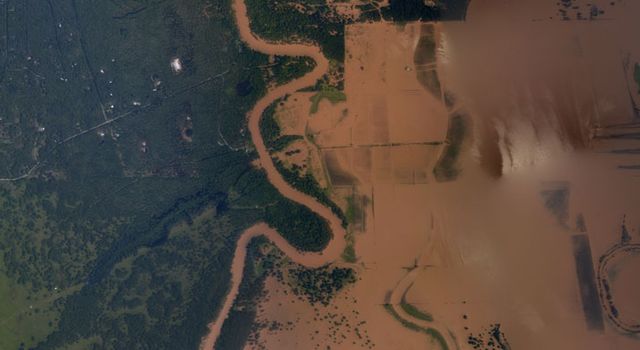The ocean floor holds unique information about Earth’s history. Scientific ocean drilling, which started 50 years ago, has yielded insights into climate change, geohazards and the key conditions for life.





Not the end, but interesting… Also, note that hupercanes are possible products of some mathematical instability, where the speed start to grow almost unlimited after some threshold. Buts Cat 6 is not a hypercane, as in the hypercane winds will be 500 mph.
There is no such thing as a category 6 hurricane or tropical storm — yet. But a combination of warmer oceans and more water in the atmosphere could make the devastation of 2017 pale in comparison .

WASHINGTON (AP) — A warmer world makes for nastier hurricanes. Scientists say they are wetter, possess more energy and intensify faster.
Their storm surges are more destructive because climate change has already made the seas rise. And lately, the storms seem to be stalling more often and thus dumping more rain.
Study after study shows that climate change in general makes hurricanes worse. But determining the role of global warming in a specific storm such as Hurricane Florence or Typhoon Mangkhut is not so simple — at least not without detailed statistical and computer analyses.

(AP) — California Gov. Jerry Brown said Friday that the state plans to launch its “own damn satellite” into orbit to battle climate change.
The man the late Chicago columnist Mike Royko famously dubbed “Gov. Moonbeam” made the announcement at the conclusion of a two-day climate summit he organized in San Francisco.
Brown said state officials will work with the San Francisco-based company Planet Labs to develop a satellite to track climate-change causing pollutants. Brown said the earth-imaging company has launched 150 satellites.

$82 Trillion to convert a desert to land that could grow crops to help feed the world…is it worth it?
Researchers simulated the effects of around 79 terawatts of solar panels and 3 terawatts of wind turbines. Computer modeling looked at the effect of covering 20 percent of the largest desert on the planet in solar panels and installing three million wind turbines.
There would be 16X the rain in the aridest parts of the Sahara, and double that of the Sahel.
It should be noted that massive amounts of solar and wind power does directly alter the climate.

Realistic climate simulations require huge reserves of computational power. An LMU study now shows that new algorithms allow interactions in the atmosphere to be modeled more rapidly without loss of reliability.
Forecasting global and local climates requires the construction and testing of mathematical climate models. Since such models must incorporate a plethora of physical processes and interactions, climate simulations require enormous amounts of computational power. And even the best models inevitably have limitations, since the phenomena involved can never be modeled in sufficient detail. In a project carried out in the context of the DFG-funded Collaborative Research Center “Waves to Weather”, Stephan Rasp of the Institute of Theoretical Meteorology at LMU (Director: Professor George Craig) has now looked at the question of whether the application of artificial intelligence can improve the efficacy of climate modelling. The study, which was performed in collaboration with Professor Mike Pritchard of the University of California at Irvine und Pierre Gentine of Columbia University in New York, appears in the journal PNAS.
General circulation models typically simulate the global behavior of the atmosphere on grids whose cells have dimensions of around 50 km. Even using state-of-the-art supercomputers the relevant physical processes that take place in the atmosphere are simply too complex to be modelled at the necessary level of detail. One prominent example concerns the modelling of clouds which have a crucial influence on climate. They transport heat and moisture, produce precipitation, as well as absorb and reflect solar radiation, for instance. Many clouds extend over distances of only a few hundred meters, much smaller than the grid cells typically used in simulations – and they are highly dynamic. Both features make them extremely difficult to model realistically. Hence today’s climate models lack at least one vital ingredient, and in this respect, only provide an approximate description of the Earth system.

ICYMI overnight: A little more than an hour after its launch window opened—the delay was due to remnant thunderstorms in the area—#SpaceX’s Falcon 9 rocket launched from Florida early on Monday morning. The rocket’s first stage made a flawless flight, and then descended to a drone ship in the Atlantic Ocean and safely landed.
The company has now flown 16 missions this year.

Think of the Sahara, with its windswept dunes shining in the sunlight. Some people might see barren land, with minimal water or life and scorching temperatures. Others see a potential solution to a looming energy crisis, and one that could potentially make it rain in one of the largest deserts in the world.
In a paper published this week in Science researchers found that by building out huge wind and solar farms across the desert, they could not only provide a stunning amount of power to Europe, Africa, and the Middle East, but they could simultaneously change the climate—increasing heat, but also increasing precipitation and vegetation in areas that could sorely use the added greenery. They estimate that such a venture could double the rainfall in the region, and increase vegetation cover by about 20 percent.
How much green are we talking? The Sahara covers 3.55 million square miles (9.2 million square kilometers). In the study, the researchers ran computer models that placed wind turbines across the desert close to a mile apart, and covered 20 percent of the desert with solar panels in different configurations (sometimes the panels were spread across the desert in a checkerboard pattern, and in other cases were concentrated in quadrants). Smaller coverage produced smaller climate impacts—in this case, less precipitation—but much of it depended on the location of the turbines and panels as well. For example, installing panels in the northwest corner had a larger impact than the other three desert options.